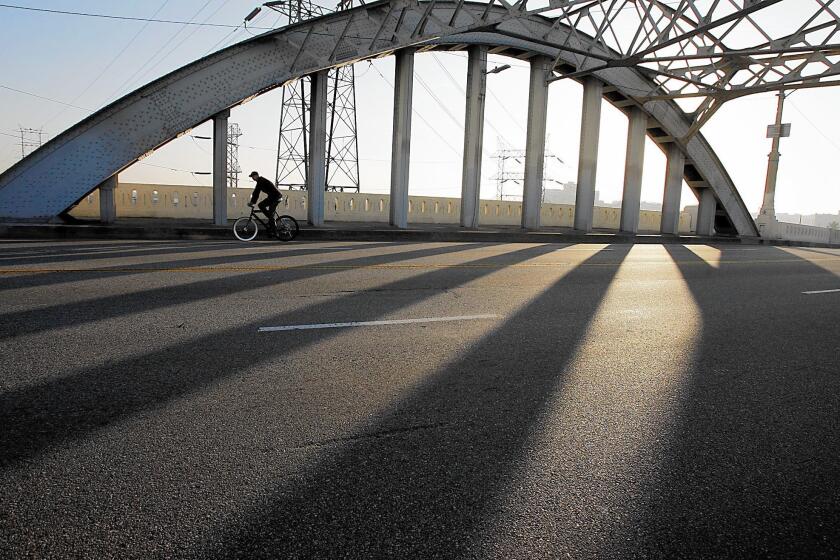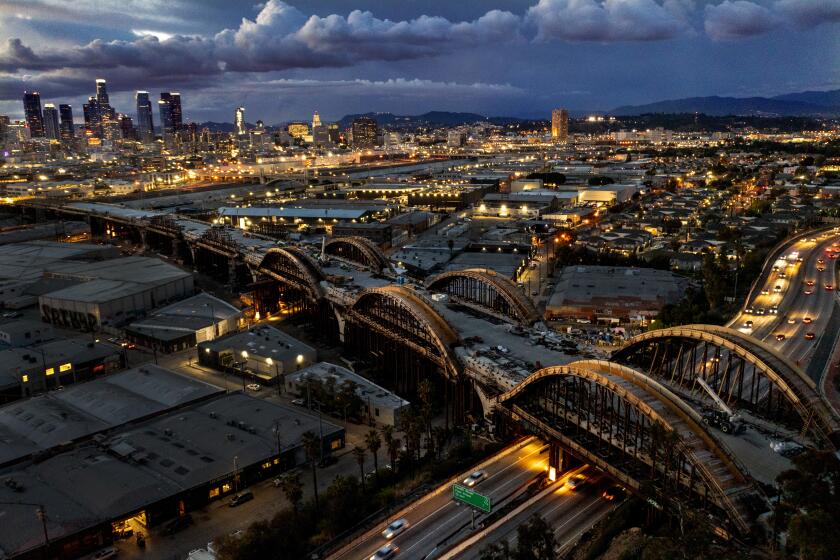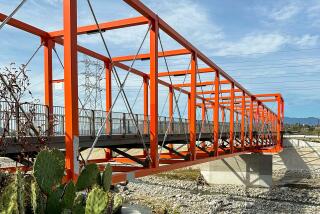
Descend one of the pedestrian ramps of the 6th Street Viaduct and there is a point at which it boomerangs under the bridge’s deck, suspending you above the Boyle Heights flats a couple of dozen feet below. You’ll catch glimpses of rail yards and old warehouses drenched in graffiti. Hovering overhead is the underbelly of the bridge, a gentle concrete curve that evokes the ribbed carapace of some land-dwelling kaiju.
“I love this space,” says architect Michael Maltzan. “This is like a huge civic hall.”
Construction workers and engineers are putting the finishing touches on the new 6th Street Viaduct, an enormous, decadelong public works project — current tally: $588 million — that is set to open early next month. (A community celebration is scheduled for July 9 and 10, after which the bridge will be officially open for business.)
It’s a project that has been scrutinized and dissected, hailed and assailed. Soon it will beckon the public with a new form, a series of arches that bound effortlessly over a panoply of industrial sites just east of downtown, redefining the city’s skyline in the process. It also will have a revised function — one that attempts to soften the hard edges of transportation infrastructure, which have generally shown little regard for the communities in its path.
The project marks a moment in the limelight for Maltzan and the two-dozen members of Michael Maltzan Architecture who designed the bridge as part of a team that also included engineering firm HNTB and AC Martin Partners (which worked on the urban plan).
Maltzan is excited — as excited as this famously soft-spoken architect gets. “I don’t get tired of it,” he says, as he surveys a truck carting away detritus. “Especially as the construction comes to completion.”
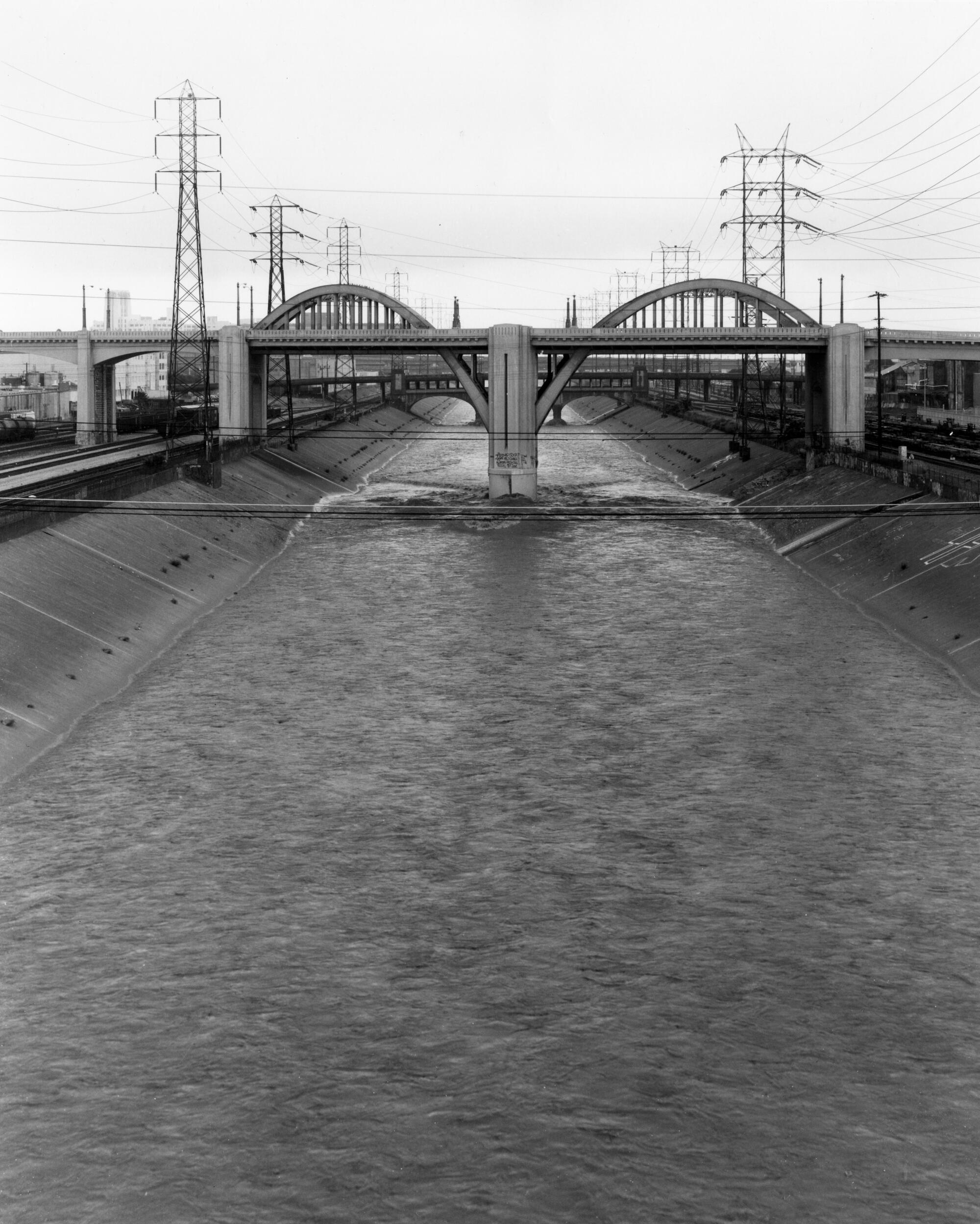
Maltzan’s design for the 6th Street Viaduct replaces a 1932-era design by city engineer Merrill Butler that had succumbed to structural problems. That bridge — a beloved lowriding thoroughfare and international cinematic icon — consisted of a flat deck that traveled over an industrial spaghetti of railways, freeways and the channelized Los Angeles River. Its most notable flourish was a pair of steel arches that marked the point at which the bridge traveled over the water.
Maltzan’s design tips its hat to Butler — while also creating something daringly new. Spanning 3,500 feet from end to end are 10 pairs of arches whose forms echo Butler’s design, with the tallest arches framing the river crossing. Imagine the ebullient pattern left by a bouncing ball or a rock skipping across water.
But even as he nods to history — aesthetics were important to Butler, Maltzan notes — the team was intent on making improvements.
“The bridge,” says Maltzan, “needed to represent something that could knit the city together in a more consequential way.”
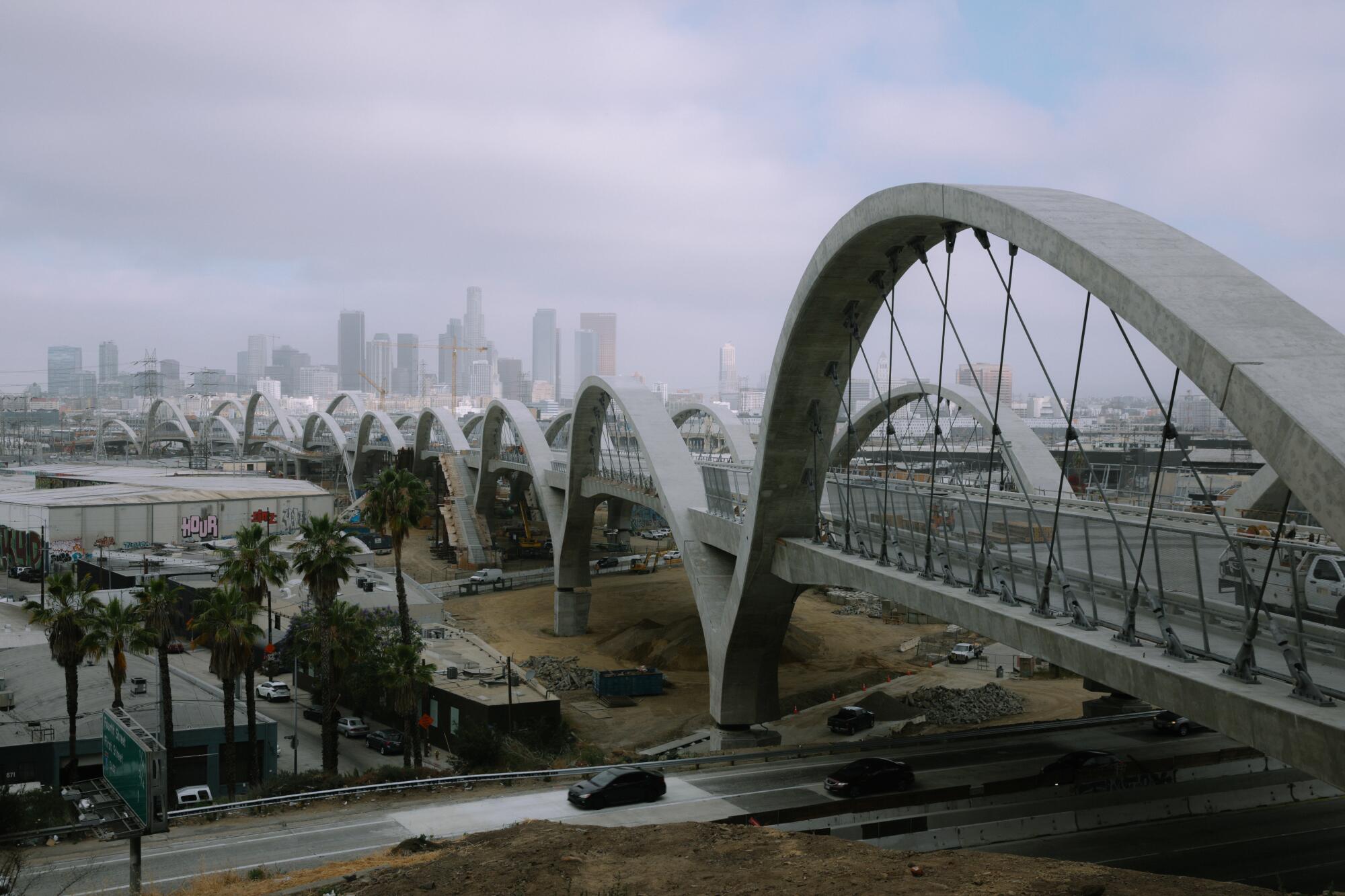
No one expected the squiggle.
This included some obvious design choices: adding protected bike lanes and pedestrian areas to encourage its use as a multimodal artery.
It also resulted in some interesting new features below the deck — which is why Maltzan is particularly obsessed with this space.
On the east side of the river, the viaduct touches down in Boyle Heights, a neighborhood that over the last century has been riven by freeways and rail lines. The 6th Street Viaduct, in its original iteration, was a key point of connection to downtown. But its deck, which begins at Whittier Boulevard and Boyle Avenue, flew over the neighborhood’s flats, cutting off easy access between the residential areas, located on a bluff, to the light industrial areas below.
Maltzan says it was therefore important to make vertical connections — from the bridge’s deck to the flats where, by 2024, a 12-acre community park will rise (designed by landscape architects Hargreaves Jones). To create this access, the architects incorporated staircases into the design, as well as a pair of broad ADA-compliant ramps accessible to pedestrians and cyclists. One of these takes a particularly dramatic helical shape. (Looking forward to seeing it in cinema.)
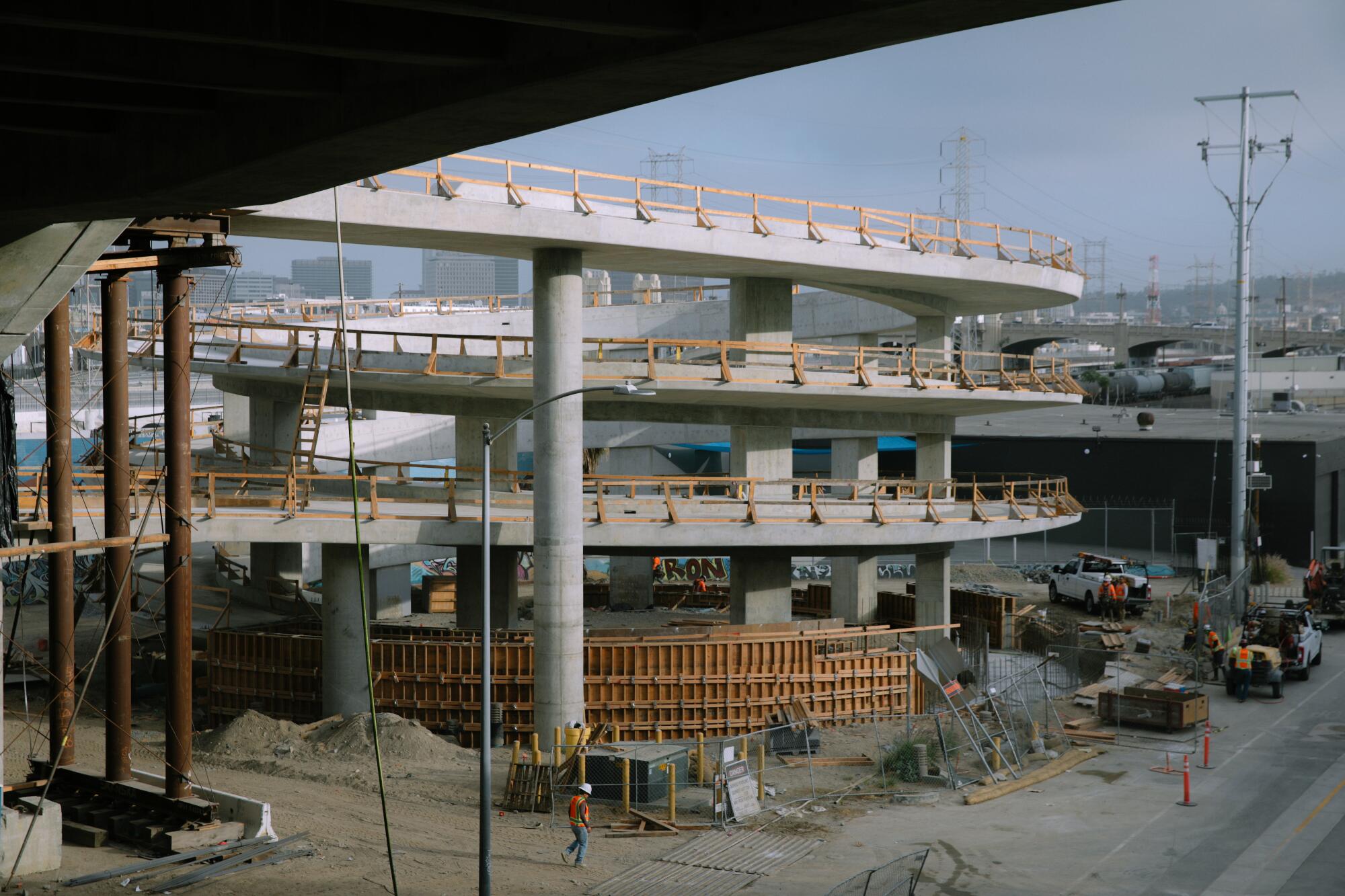
The design of a shiny new bridge has sparked concerns about further gentrification in Boyle Heights, a working-class, predominantly Latino community that has grappled with a burgeoning gallery district (now all but gone), as well as the possible redevelopment of the 1927 Sears, Roebuck & Co. building into market-rate lofts. The park will also be the second in the neighborhood to be tucked beneath transportation infrastructure — not exactly a picture of urban equity. (The other, Hollenbeck Park, has the 5 Freeway running through it.)
But Maltzan says it would have been untenable to replace the old bridge with a design that didn’t attempt to address the mistakes of the past — and didn’t take cyclists and pedestrians into better account. (He is an avid cyclist.)
“We spend enormous amounts of money on infrastructure,” he explains. “We should demand that infrastructure do more for the city.”

The bridge’s ribbed undercarriage does bring greater intention to infrastructure design. A bridge with a steel deck would have been more inflexible, a harder surface overhead. By crafting the structure out of concrete, the architects were able to give it softer, more elegant contours.
Plus, if you’re a structure geek, these ribs reveal the ways in which the bridge’s weight is distributed. As Tim Williams, a managing principal at Maltzan’s firm, tells me later: “If you’re a civil engineer, you would really love the underside. It’s like looking underneath the hood of a car.”
New design showcases iconic arches from the original bridge
For Maltzan, who is 62 — adolescence, as far as architecture is concerned — the 6th Street Viaduct will function as his most visible mark on Los Angeles.
Born outside of Levittown on Long Island, Maltzan first came to L.A. as part of a student research trip with Harvard University’s graduate school of design in 1987. “All of my classmates couldn’t wait to get out of here,” he recalls. “But I felt really comfortable” — noting his familiarity with suburban environments.
The second time he came to L.A. was in 1988 to work in Frank Gehry’s office, on the design of Walt Disney Concert Hall. That time he stayed for good.
Since breaking out on his own in 1993, the architect has worked on buildings that have experimented with purpose and form, as well as construction technique. And there are a lot of them. In fact, you may have, at one point or another, set foot in a Maltzan structure. His firm has designed dormitories, educational buildings, apartment houses and permanent supportive housing. They’ve also designed museum installations — including the ongoing fashion exhibition “Lee Alexander McQueen: Mind, Mythos, Muse” at the Los Angeles County Museum of Art.
But one of the major throughlines of his practice has been in the cultural arena.
The project that built Maltzan’s reputation in L.A. was the design of the Inner-City Arts complex, an early arts education campus that in the ‘90s transformed a gritty acre in skid row into a gleaming village of buildings for at-risk youth. He subsequently drew national attention for thoughtfully repurposing an old stapler factory in Queens, N.Y., into a temporary home for the Museum of Modern Art while the museum expanded its Manhattan building.
“The overall effect is mesmerizing,” wrote former Times architecture critic Nicolai Ourossoff of the MoMA project. “Maltzan has created the museum’s identity out of almost nothing — some paint, some boxes, a few fluorescent lamps.”
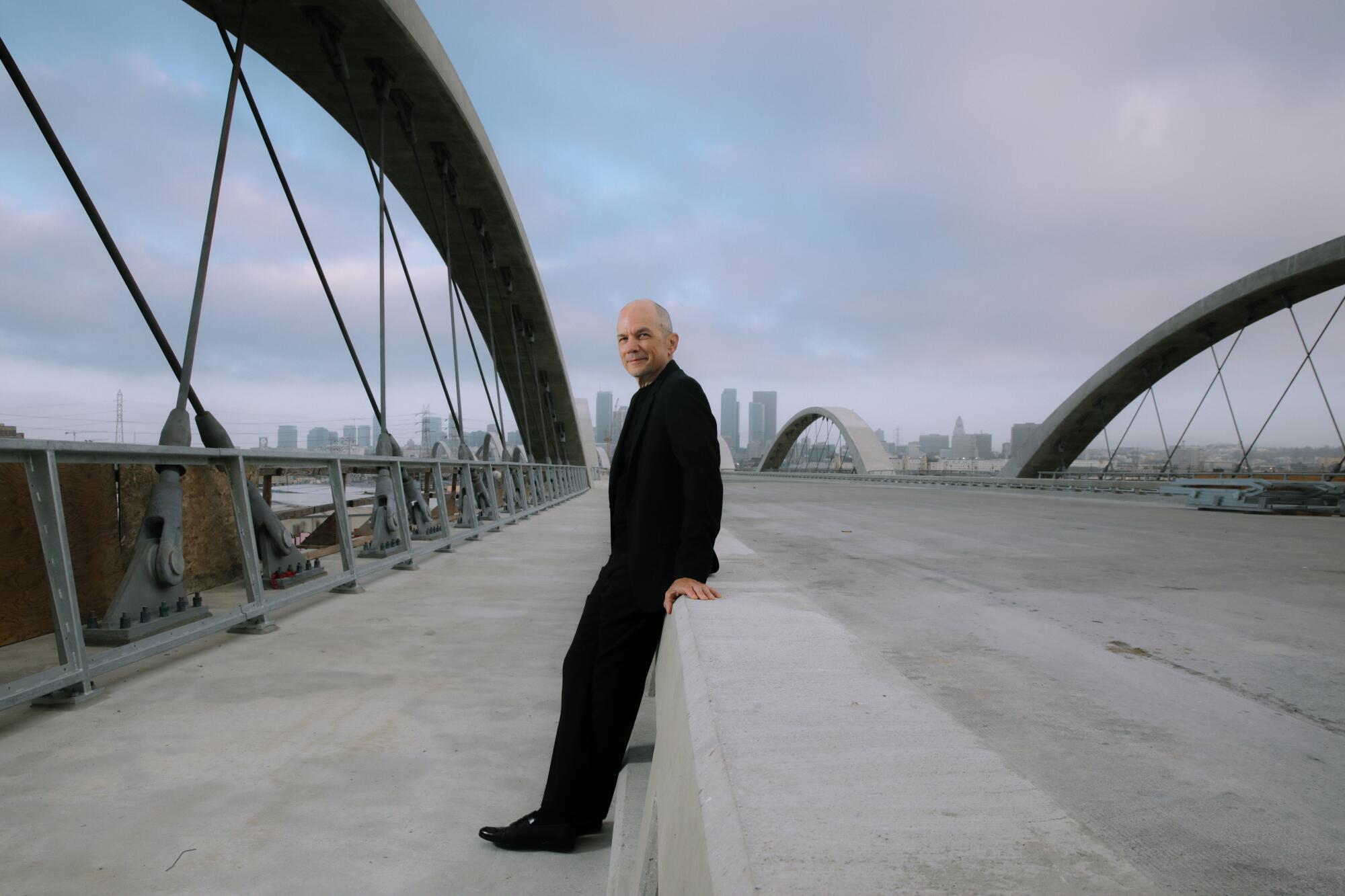
For the record:
9:08 a.m. June 30, 2022An earlier version of this article included a photo caption that said a concrete guardrail on the bridge will protect a path for pedestrians and cyclists. That particular path is for pedestrians only.
Closer to home, Maltzan has overseen a two-decade-long master plan for the Hammer Museum, which has expanded and tweaked Edward Larrabee Barnes’ original Modernist design from the ‘80s. He raised ceilings, added a theater and, most recently, created a gallery for prints. The museum has been able to achieve all of this without closing down.
The work reveals an architect who is willing to fade into the background when necessary. “In some places, our work there is very visible,” says Maltzan, “in other cases it is not.”
One of the eye-catching additions is a second-story pedestrian bridge, added in 2014, that helped to unify the museum’s galleries. Made from perforated steel, its curved design offers a touch of panache amid the staid Modern architecture.
“It’s pure functionalism matched with incredible warmth and the ability to find a gesture that is fluid and soft in the middle of a hard thing,” says Hammer Director Ann Philbin. “It’s never just decorative.”

Michael Maltzan’s route to success is as carefully thought out as his high-profile commissions
If at the Hammer, Maltzan has helped reimagine a museum, for a recent ground-up project in Canada, he helped reimagine some of its fundamental ideals. As the viaduct’s arches were taking form in L.A., Maltzan’s studio, in collaboration with Cibinel Architecture in Winnipeg, was putting the finishing touches on Qaumajuq, a 40,000-square-foot center for Inuit art at the Winnipeg Art Gallery.
Unveiled last year, the design had to achieve a daunting number of tasks. Among them: seamlessly connect with the museum’s acclaimed Brutalist building from 1971, designed by Gustavo da Roza, while addressing a host of concerns about the ways in which Indigenous art is presented in museums (which are a Western conceit).
For his research, Maltzan made a journey to the Arctic Circle to better understand the conditions under which much of Inuit art is made and seen. (Winnipeg sits on the Canadian prairie, more than 1,000 miles to the south and a world apart from the more austere landscapes of Nunavut, where many Inuit artists are from.) He also worked with the museum’s Indigenous advisory circle, whose ideas helped shape the design.
“Inuit artists and elders would often talk about how Western space is so problematic: the defined right angles, with corners that stopped movement,” says Maltzan. “It was antithetical to the culture and the context for art.”
Instead, Maltzan sought to create gallery spaces that felt “boundless,” with gently rippling walls. Within the building, an undulating three-story visible vault showcases — and brings back to life — works that once languished in storage. From the exterior, the building resembles a glacier that has been whittled by heavy wind.
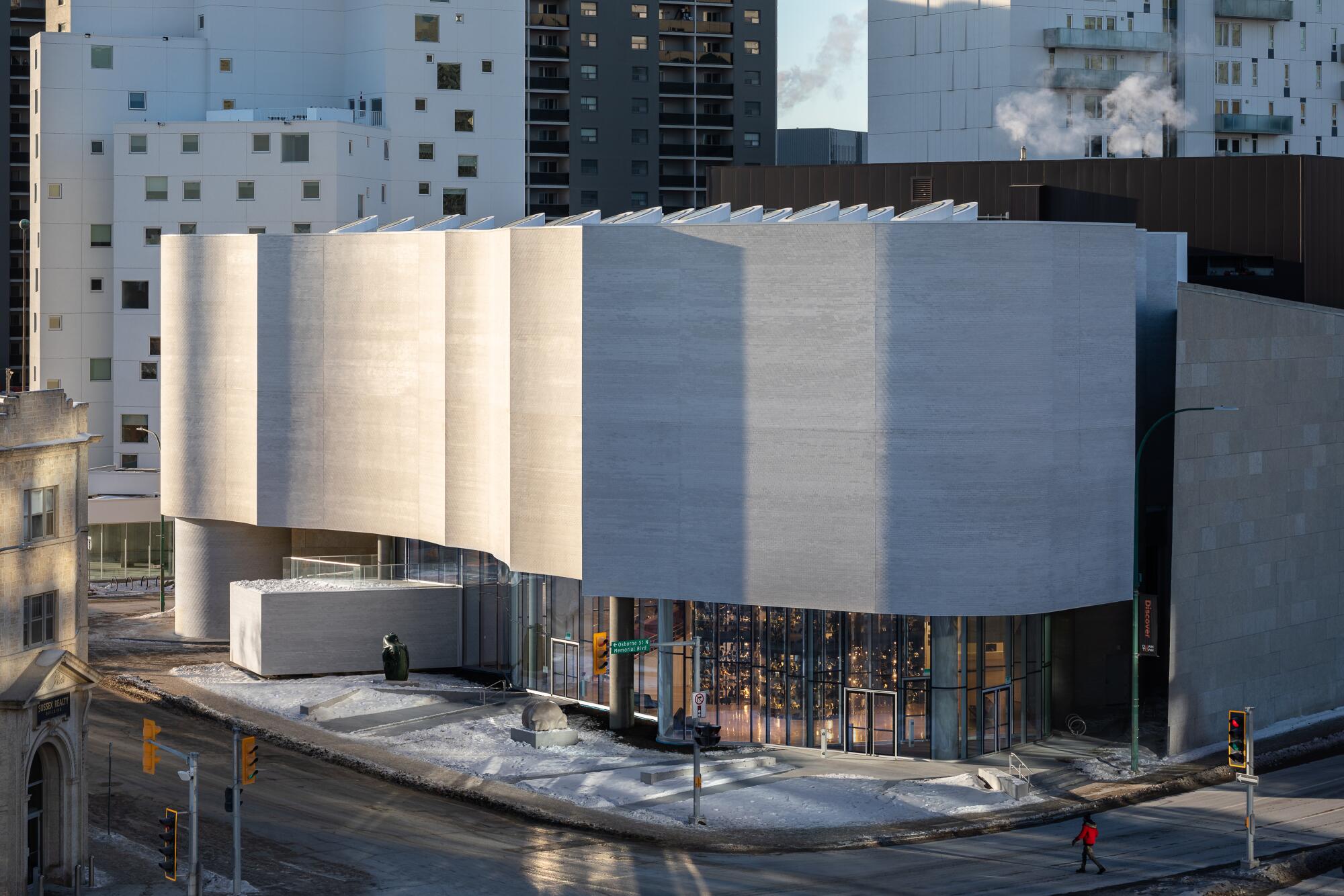
Until the 6th Street Viaduct, some of Maltzan’s most visible work in L.A. has been housing — marking a moment in which the design of housing in the city has gone from house-with-a-lawn to a whole lotta podium apartments.
Maltzan has countered with projects such as One Santa Fe, in the Arts District, which features a pair of long, narrow, six-story structures that from overhead resemble train cars, a design inspired by neighboring rail lines that lead to Union Station. The scale of the project — it is a quarter-mile long — is monumental, but Maltzan judiciously broke up all that mass for its residents with light wells, small bends and plazas. In one fell swoop, the complex added 438 homes to the neighborhood, a portion of which were set aside as affordable units.
It contends with a difficult site — a narrow strip of land bathed in the din of moving trains — with efficiency, albeit one that feels industrial-strength. A friend of mine who lives in the complex likens the design to Dutch social housing.
More significant has been Maltzan’s long-running work with the Skid Row Housing Trust, which represents some of the earliest experiments in permanent supportive housing in Los Angeles.
Around downtown, this includes the Rainbow Apartments, which are built around a courtyard on San Pedro Street (completed in 2006); the New Carver Apartments (2009), which occupy a distinctive pleated structure that peaks out above the westbound 10 Freeway, as well as the Star Apartments (2013), which are stacked, Tetris-like, over a block of old commercial storefronts on E. 6th Street.
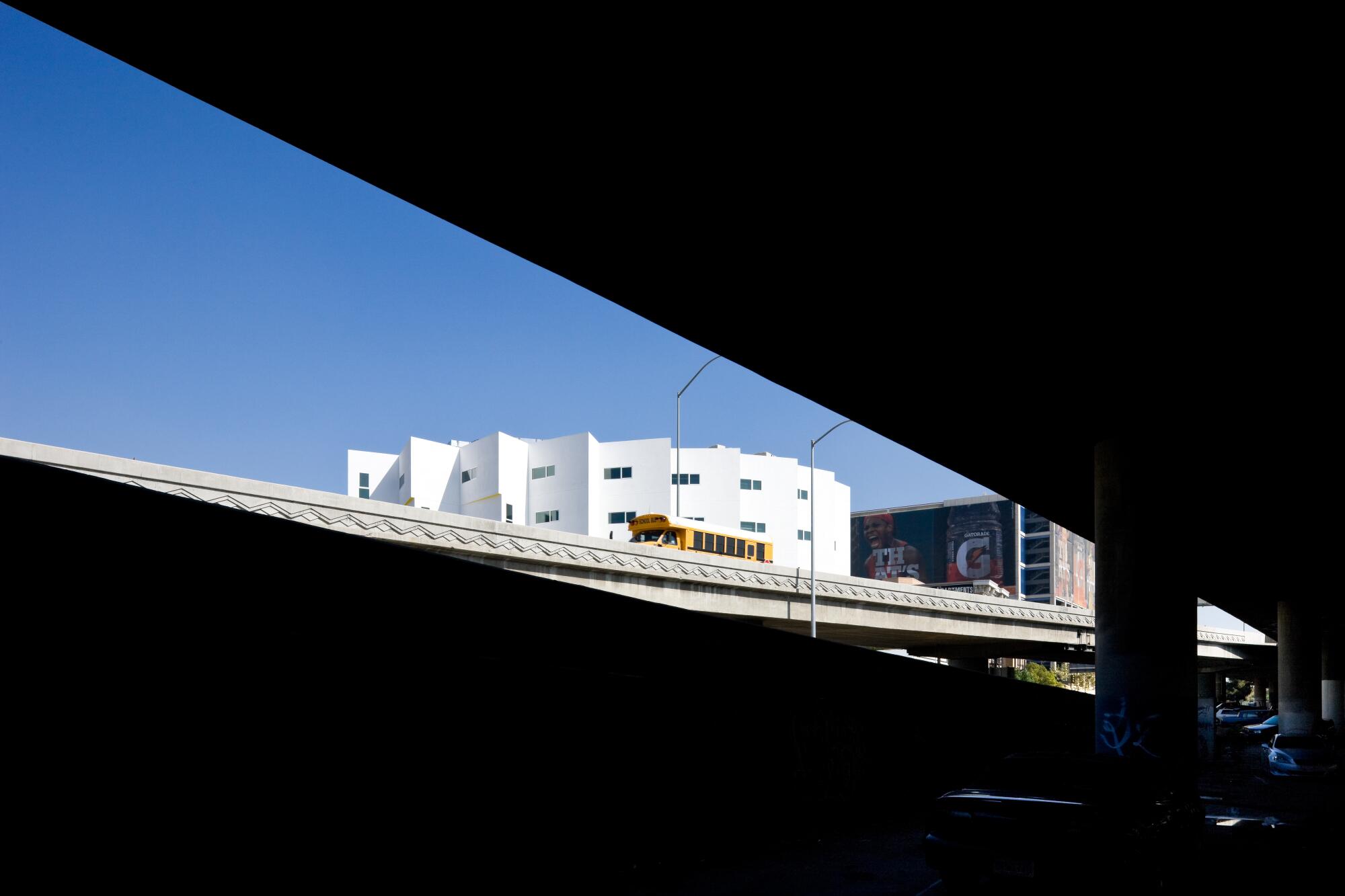
Each design has evolved from one iteration to the next, each adapting to complex sites. The New Carver’s inhospitable freeway-adjacent location helped determine its inward-facing form, centered on a futuristic central atrium (which could offer more shade). But they have also evolved in the ways in which they serve their clientele — over time, adding public spaces, at various scales, so tenants can choose to gather or find some alone time.
It’s not about creating a cookie-cutter template, says Hannah Hoyt, a designer in Maltzan’s office. “They are really different. There’s not a visual move that is signature.”
Each design has challenged preconceived notions about architecture for the unhoused. “People think that it will look terrible,” says Mike Alvidrez, a former chief executive of the Skid Row Housing Trust, who now serves as an ambassador for the organization. “Michael’s buildings really helped flip the script — and not just for the public, but for the government.”
The designs have also innovated the ways in which we build in L.A.
Star Apartments were made out of prefabricated modular units that could be craned into place, a technique that saves time and the amount of land needed for staging construction. The Crest Apartments, a 2016 project for formerly unhoused military veterans in Van Nuys, employs prefabricated walls — another timesaver.
“Every project,” says Williams, “pushes harder and further on how to build faster and better housing.”

The 6th Street Viaduct is not Maltzan’s first bridge. In 2016, the firm completed a transit bridge in Chengdu, China. But so far, it’s the biggest — and it’s the one that will most reveal his thinking about Los Angeles: a city can be quite fugitive, eluding classical definitions of space.
It also reflects the ways in which Maltzan is inspired by form and by color. His chosen shade is often a gleaming white — a white that former Times architecture critic Christopher Hawthorne once compared to “the surprising brightness of a soap-opera actor’s teeth.”
It’s a shade that may seem almost too radiant, too impractical, in a city whose palette leans to smog and cement. But, in white, Maltzan sees the history of stucco plaster as it has been employed in Southern California’s vernacular architecture. It also serves as canvas for those magic moments of shifting light. In that space, he says, he finds “lightness and optimism.”
Lightness and optimism.
A good way of describing the ebullient forms of the viaduct — a structure that connects downtown to points east, as well as L.A.’s past with its future. “It’s an opportunity,” says Maltzan, “to represent an idea of Los Angeles as it continues to evolve.”
That is a hopeful idea. Lucky will be the first lowriders to cross its span.
More to Read
The biggest entertainment stories
Get our big stories about Hollywood, film, television, music, arts, culture and more right in your inbox as soon as they publish.
You may occasionally receive promotional content from the Los Angeles Times.
